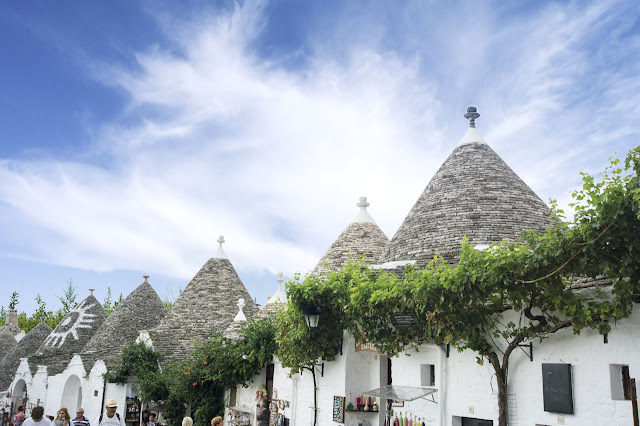Puglia is one of Italy’s southernmost regions located on the heel of the boot. It’s a narrow region only about 35 miles wide from the Adriatic Sea to the Appennines, but has over 200 miles of coastline. When it comes to wine it is one of the top largest wine producing regions in Italy alongside Sicily and the Veneto. It’s also well known for its olive oil production. It accounts for about half of all of Italy’s olive oil!
It’s best to understand Puglia by dividing it into 3 subregions: to the north around the Foggia province, the central subregion including the provinces of Bari and Taranto, and the southern subregion with the Brindisi and Lecce subregions. The Puglia region as a whole is relatively flat filled with plains, except the northern terrain, which is hilly. It’s dry, sunny and warm climate is influenced by the cool breezes that come in from the sea. The soils are fertile made up of mostly limestone with sand and red iron soils depending on where you are within the region.Northern Puglia
There isn’t much to speak of in the northern territory of Puglia in the Foggia province. The one appellation worth noting is the San Severo DOC, which is Puglia’s oldest appellation established in 1968. A wide range of wines are produced in this DOC and it’s an area that is highly productive. The reds are primarily based on the Montepulciano grape, while the white wines are based on Bombino Bianco and Trebbiano. I'll cover more about Puglia’s grapes specifically in a later article this month.
Central Puglia
Central Puglia hosts 3 of the 4 DOCG appellations of Puglia under the Castel del Monte name. Its name means “castle on the mountain”, which is named after the 13th century medieval octogonal fort located up on the hill. This is also a UNESCO world heritage site as well. It‘s located on the Murge plateau that has elevations from 600-1,500 feet. This plateau is known for the trulli that you may have seen in articles written about Puglia. The trulli are white washed conical stone houses largely populated in Alberobello that have also become a UNESCO world heritage site.
 |
| Trulli in Alberobello |
Castel del Monte is also a DOC, but the 3 DOCG are Castel del Monte Rosso Riserva DOCG, which is a blend of the Nero di Troia grape with Montepulciano and Aglianico. There is also Castel del Monte Nero di Troia Riserva DOCG that is made from a minimum of 90% Nero di Troia. Lastly, the Castel del Monte Bombino Nero DOCG is a rose made from the rediscovered grape Bombino Nero.
 |
| Castel del Monte |
The Moscato di Trani DOC is named after the town of Trani where the vineyards are located. The wines here are a sweeter style based on the Moscato Bianco grape. In the Itria Valley there are two appellations, Locorotondo DOC and Martina Franca DOC, both appellations produce white blends from Verdeca and Bianco d’Alessano.
Southern Puglia
Southern Puglia has a couple of the appellations that you’ll see the most in the market, Salice Salentino DOC and Primitivo di Manduria DOCG. Both these regions cover two of the most popular grapes of Puglia, Primitivo and Negroamaro. The Salice Salentino DOC is located on the heel of the boot on the Salento peninsula. The wines here are primarily made from Negroamaro, a full-bodied, ripe fruit driven wine with some spice.
Primitivo di Manduria is a territory that occupies the plains around the town of Taranto out to the coast to the Gulf of Taranto. It has both a DOC and DOCG designation and was the first DOCG in Puglia in 2011. Primitivo is the star grape of this area, which is the same a the Zinfandel grape you’re most familiar with. It is said that Primitivo originated from Croatia. The wines in the Primitivo di Manduria DOCG are produced from overripened grapes in sweet style or in the appassimento style made from Primitivo grapes where those from the DOC are produced as a dry wine.
Another area noteworthy in southern Puglia is the Copertino DOC named after the town in which it is grown, Copertino. This area borders the Salice Salentino area and also grows Negroamaro as well. A few others to be familiar with are Brindisi DOC, Squinzano DOC and Lizzano DOC.

Always great Italian Wine information!
ReplyDelete